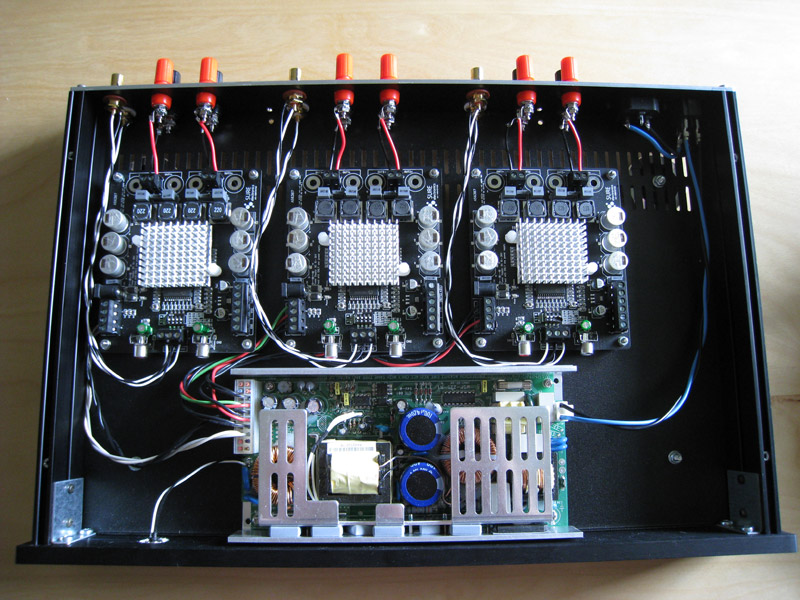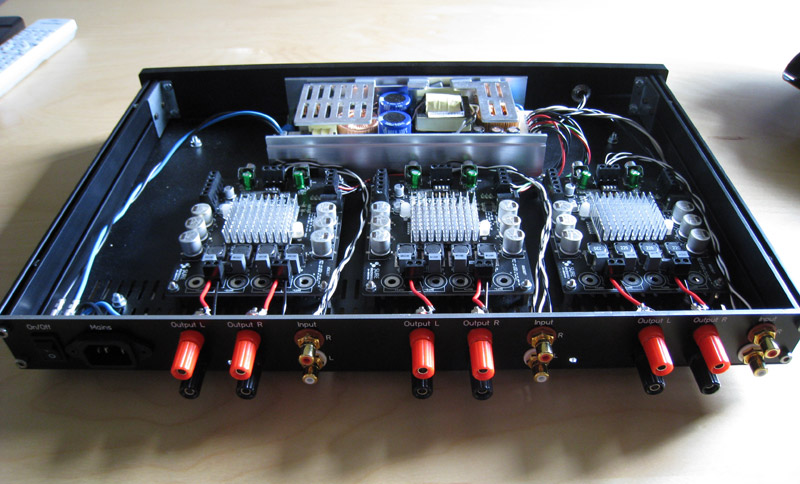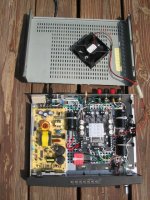Your meltdown did not seem to be directly related to voltage, but rather to cooling. It has been well documented on this thread that extra cooling is needed if you run these amps hard. But that is true at 24 volts or 30 volts or 36 volts.
Several suggestions for additional cooling are in this thread.
-dr_vega
Several suggestions for additional cooling are in this thread.
-dr_vega
gooki said:Cheers guys, so the question remains 12, 24 or 36 volt?
The main reason I'm asking is the 12 volt is cheaper, and I can use it for other stuff. But if i'll get better performance at 24v or 36v then I'll happily spring the extra $10.
I'm guessing that 12 volts won't be loud enough for you. At 12 volts, you're basically at the TA2020 level. It would be a shame to have a TK2050 and not use it. I think both 24 and 36 volts are good choices.
Of course, if you get 24 volts, you'll probably want to upgrade to 36 volts in 6 months. On the other hand, if you go with 36 volts, you'll need to add a fan or a bigger heat sink, or both.
-dr_vega
Can I connect the -12V line to GND and +12 line to VCC to create the effect of supplying the board with 24V?
No you can not as the -12V line has only very low power.For a lot of reasons using a PC supply is a bad idea for powering an amplifier.
Finally managed to finish my 6-channel amp based on the Sure 2*100W. I am still waiting for the Zobel components which I need to install, but so far I am pretty happy with the sound. The boards are unmodified except for a Nichicon Muse 4.7uF bipolar input cap. i'll spend some more time listening before I consider further mods.
Pics:


/U.
Pics:


/U.
Thanks. The PSU is a 24V Mean Well USP-225 (turned up to 27V). It might be a little small for three boards but for the price I paid it was a steal (ebay), it's normally a bit pricey. Anyway, the amp sounds fine and there's no indication that I am close to the limit, even when playing loudly in my (smallish) listening room.
First impression is that the amp is a little bright for my taste, but hopefully the Zobels will fix that (why haven't the f*****s mounted those components on the board?)
/U.
First impression is that the amp is a little bright for my taste, but hopefully the Zobels will fix that (why haven't the f*****s mounted those components on the board?)
/U.
Nisbeth said:
First impression is that the amp is a little bright for my taste, but hopefully the Zobels will fix that (why haven't the f*****s mounted those components on the board?)
/U.
I think you'll find the amp smooths out and opens up after some burn-in. Most of the difference will happen in the first 20 hours, but it will continue to improve slightly for 100 hours or so.
In theory, the Zobel circuit shouldn't affect the sound, but some of the people on this board say their highs receded a bit when they put the Zobel in.
It's funny, Sure put in the Zobel resisters (using 4 to get up to 1 watt) and then they left out the cap! Maybe the surface-mount cap they designed the board for didn't sound good and they found there wasn't room under the heatsink for a proper .47uF MKP? Or maybe there was an assembly line glitch and they wound up with 10,000 boards without Zobel caps? The up side is that it makes upgrading the Zobel components both easier and necessary.
I've been trying to figure out the Zobel values that Tripath specs. The 10 ohm resister is approximately right if you have an 8 ohm speaker (according to their formula), but the cap value makes no sense to me at any reasonable speaker Le. Does anyone understand what Tripath is after here?
-dr_vega
just uploaded some pics of my build:
http://minirig.org.au/2009/07/21/minirig-sure-electronics-2-x-100w/
col.
http://minirig.org.au/2009/07/21/minirig-sure-electronics-2-x-100w/
col.
col said:just uploaded some pics of my build:
http://minirig.org.au/2009/07/21/minirig-sure-electronics-2-x-100w/
col.
Any initial impressions, before burn-in esp. in comparison to the CNX 2022 chip set?
A comparison between these two chipsets after burn-in period would be most welcomed.
Cheers.
I received my two 2*100 boards Friday and screwed them right onto the backs of my open baffle speakers to bi-amp them. I hooked them up with 32v, 2.3 amp power supplies. After a couple of hours of burn-in they sound very sweet and pure. I’m very happy with them, and they are still bone stock.
I don’t find them bright, in fact they are rolled off on the top end. In my tweeter test – the cymbal spectacular at the end of Patricia Barber’s :Too Rich for my Blood.” The cymbals are far back behind the drum pulse, they should be equal partners.
I can’t tell about the bottom end since the active crossover sends everything below 100 cps to the subwoofer.
The high end roll off may have something to do with the 22uH inductors. Tripath says the filter corner should be about 80kHz. In another place they say about 100kHz. The 15uH/.22uF filter Tripath specs in the schematic gives a filter corner at 87.6kHz. The Tripath text specs 10uH/.47uF, which produces a corner of 73.4kHz. 22uH/.47uF gives a corner of 49.6kHz, which is really too low, only two octaves above the cymbals. It could certainly be rolling off the audible spectrum, especially with the 4 ohm tweeters I’m using, which produce a more gradual filter than the sharper corner that an 8 ohm tweeter produces.
Anyway, I’m going to enjoy them for a few days before I get out the soldering iron.
Now that I think about it, some of the sound improvement may come from ditching the speaker wires. Now I’m using five inches of Cat6 instead of 12 feet of 10 gauge. That’s gotta be good for something.
-dr_vega
I don’t find them bright, in fact they are rolled off on the top end. In my tweeter test – the cymbal spectacular at the end of Patricia Barber’s :Too Rich for my Blood.” The cymbals are far back behind the drum pulse, they should be equal partners.
I can’t tell about the bottom end since the active crossover sends everything below 100 cps to the subwoofer.
The high end roll off may have something to do with the 22uH inductors. Tripath says the filter corner should be about 80kHz. In another place they say about 100kHz. The 15uH/.22uF filter Tripath specs in the schematic gives a filter corner at 87.6kHz. The Tripath text specs 10uH/.47uF, which produces a corner of 73.4kHz. 22uH/.47uF gives a corner of 49.6kHz, which is really too low, only two octaves above the cymbals. It could certainly be rolling off the audible spectrum, especially with the 4 ohm tweeters I’m using, which produce a more gradual filter than the sharper corner that an 8 ohm tweeter produces.
Anyway, I’m going to enjoy them for a few days before I get out the soldering iron.
Now that I think about it, some of the sound improvement may come from ditching the speaker wires. Now I’m using five inches of Cat6 instead of 12 feet of 10 gauge. That’s gotta be good for something.
-dr_vega
Any initial impressions, before burn-in esp. in comparison to the CNX 2022 chip set? A comparison between these two chipsets after burn-in period would be most welcomed.
Hi Ttan,
It's a bit hard to compare the two as I'm using the 2*100W to power the mids in a tri-amped system (nothing under 100hz nothing over 2k). I had the CNX TA2022 on the mids before but the noise floor was too high and it hissed on low volume levels. The 2*100W is much quieter but then I'm probably not getting anywhere near the power levels with the 19v 3.5A laptop psu I'm using (i estimate 20W per channel). The CNX TA2022 has a 22-0-22v 225VA toroidal. It definitely has a lot more grunt. I'm planning on using it to power a pair of booth monitors in a DJ PA rig.
col.
col said:just uploaded some pics of my build:
http://minirig.org.au/2009/07/21/minirig-sure-electronics-2-x-100w/
col.
what is the cool ally artwork you wove into the stock heatsink?
what is the cool ally artwork you wove into the stock heatsink?
yeah, I really like them too
I got them out of a dead 300W PC power supply. I had to cut 1cm of aluminium off of the bottom and cut them in half but I think I ended up with something that looks quite smart and is also very effective at aiding the cooling. I glued the edges in with a small amount of Loctite Tempflex. Looks like it has V8 exhaust extractors
A lot of computer power supplies (especially the cheaper ones) have those types of heatsinks.
col.
- Status
- This old topic is closed. If you want to reopen this topic, contact a moderator using the "Report Post" button.
- Home
- Amplifiers
- Class D
- Sure Electronics New Tripath Board tc2000+tp2050
